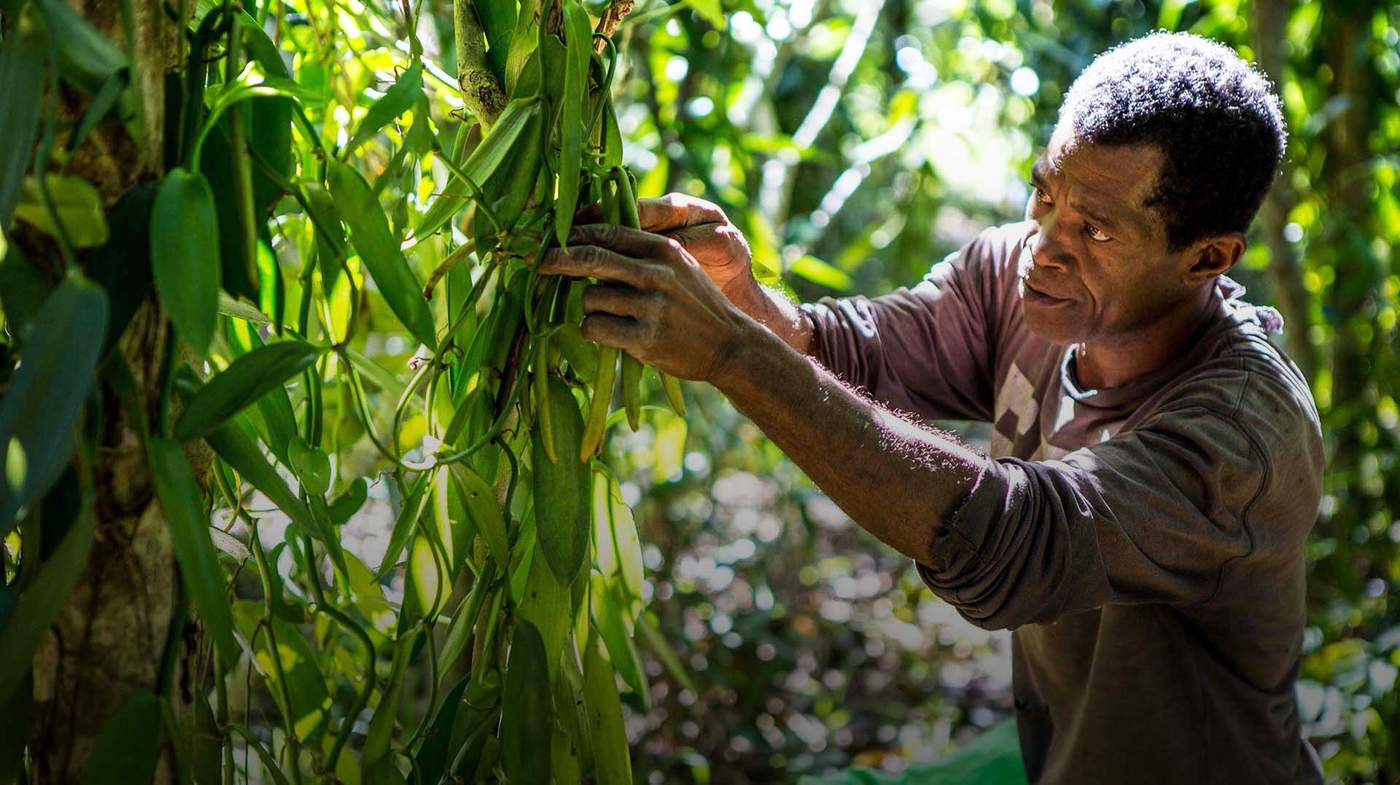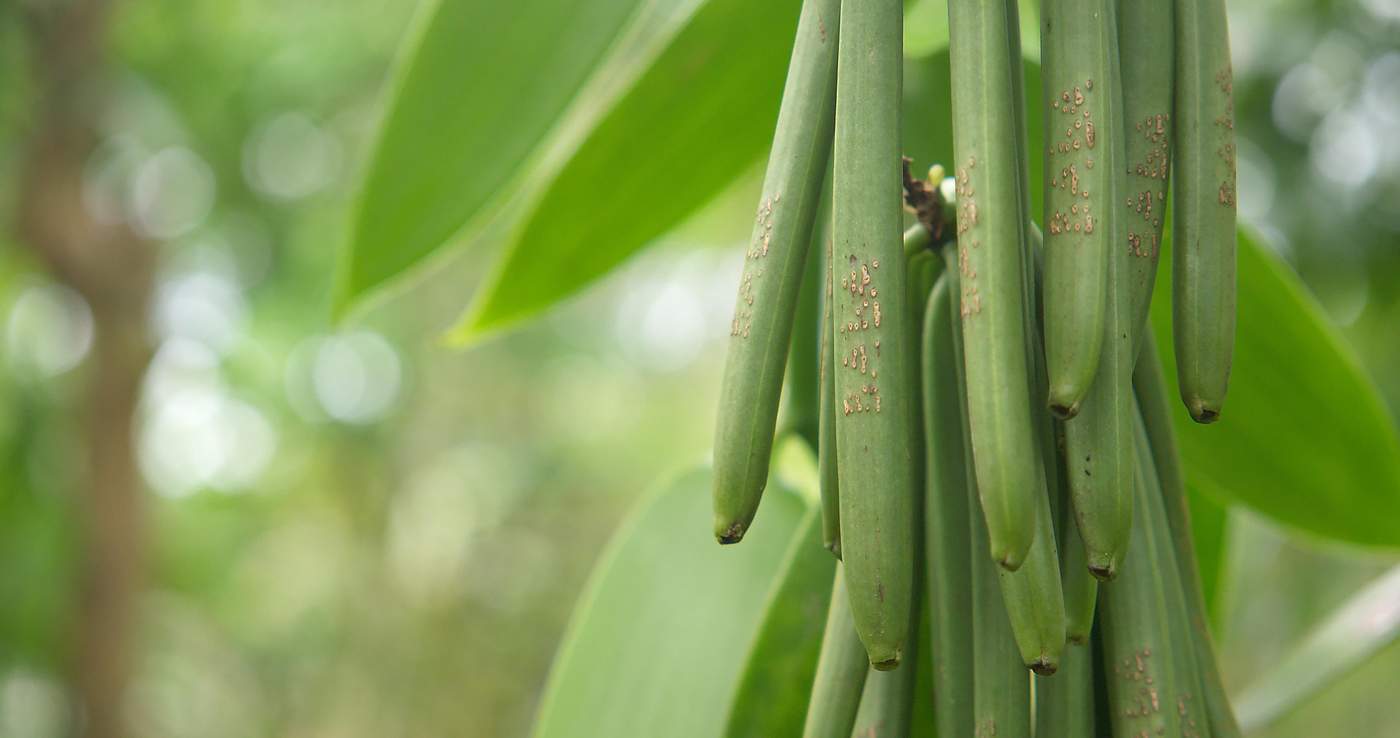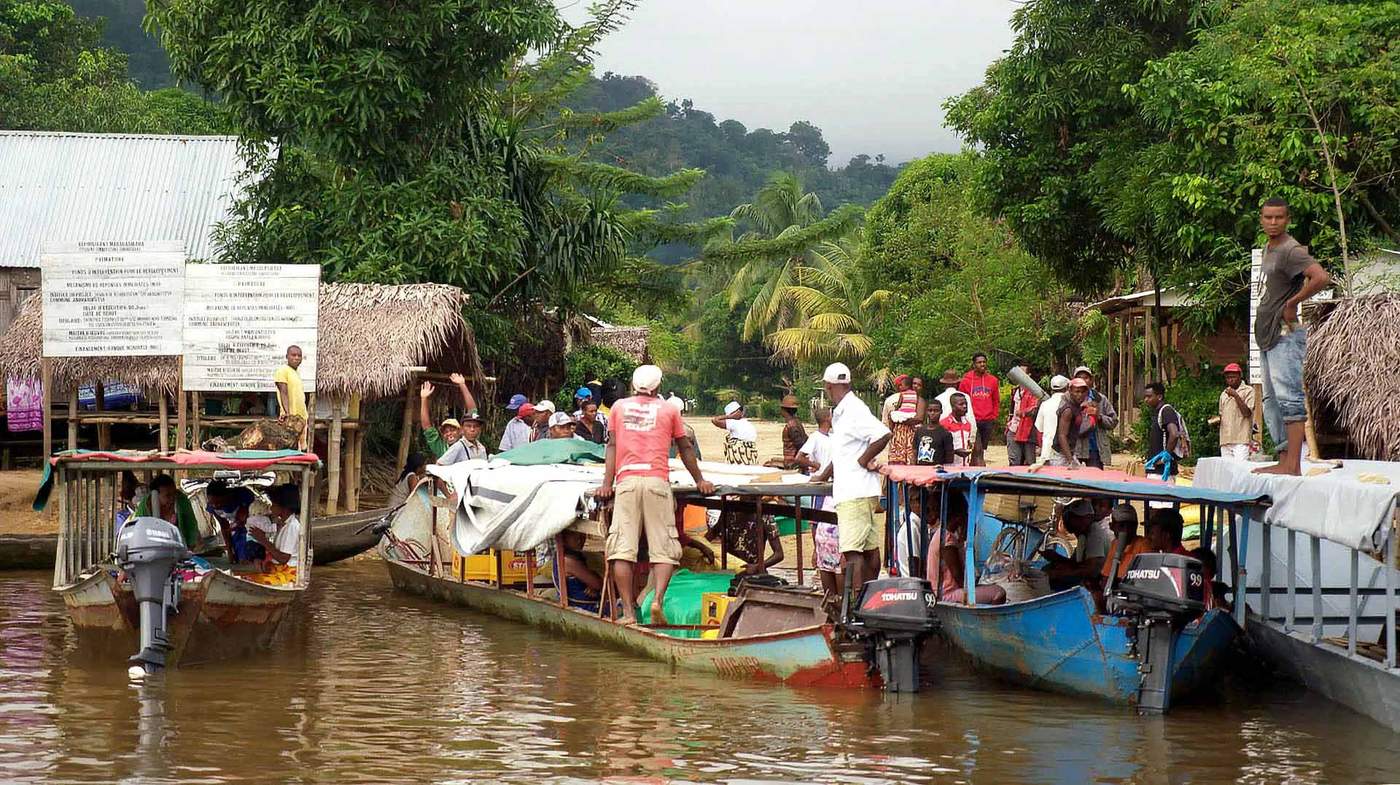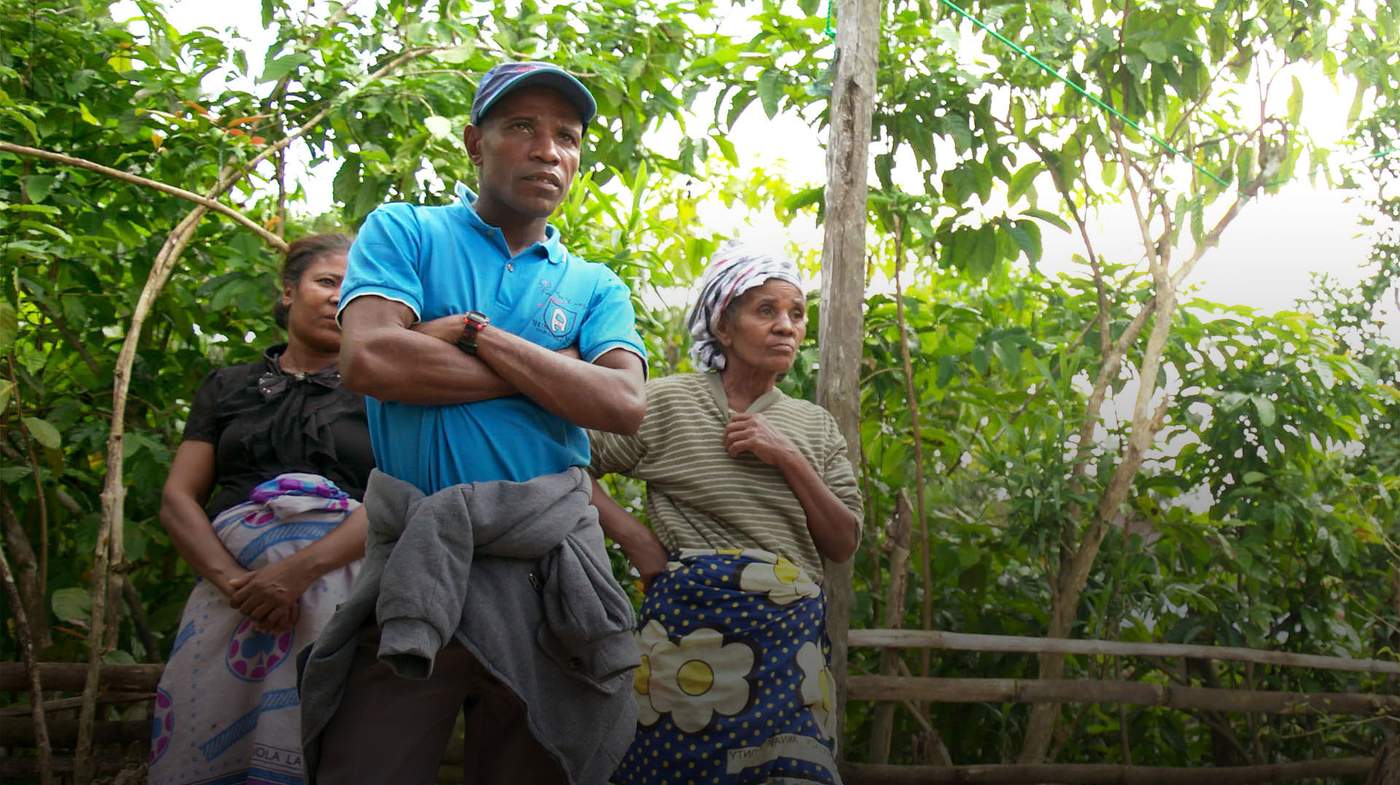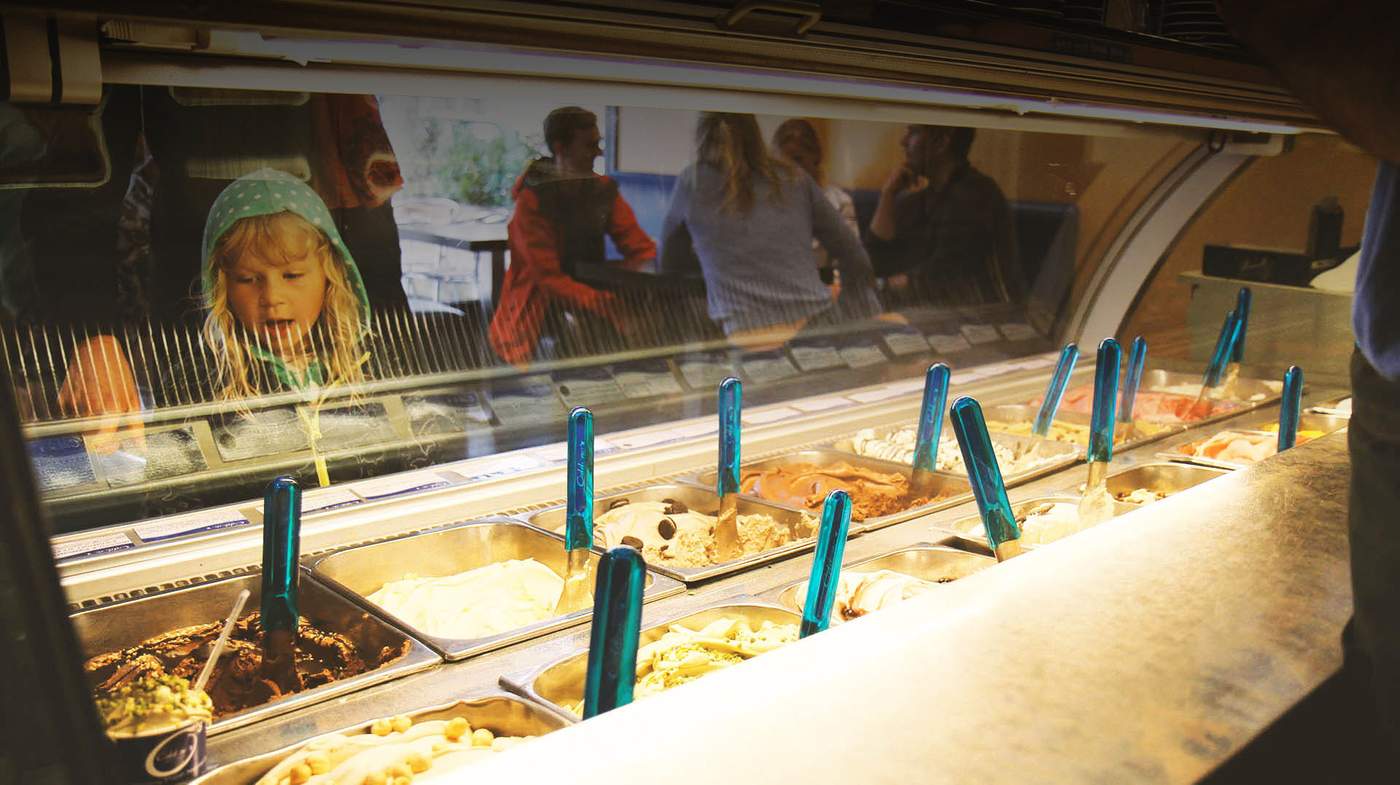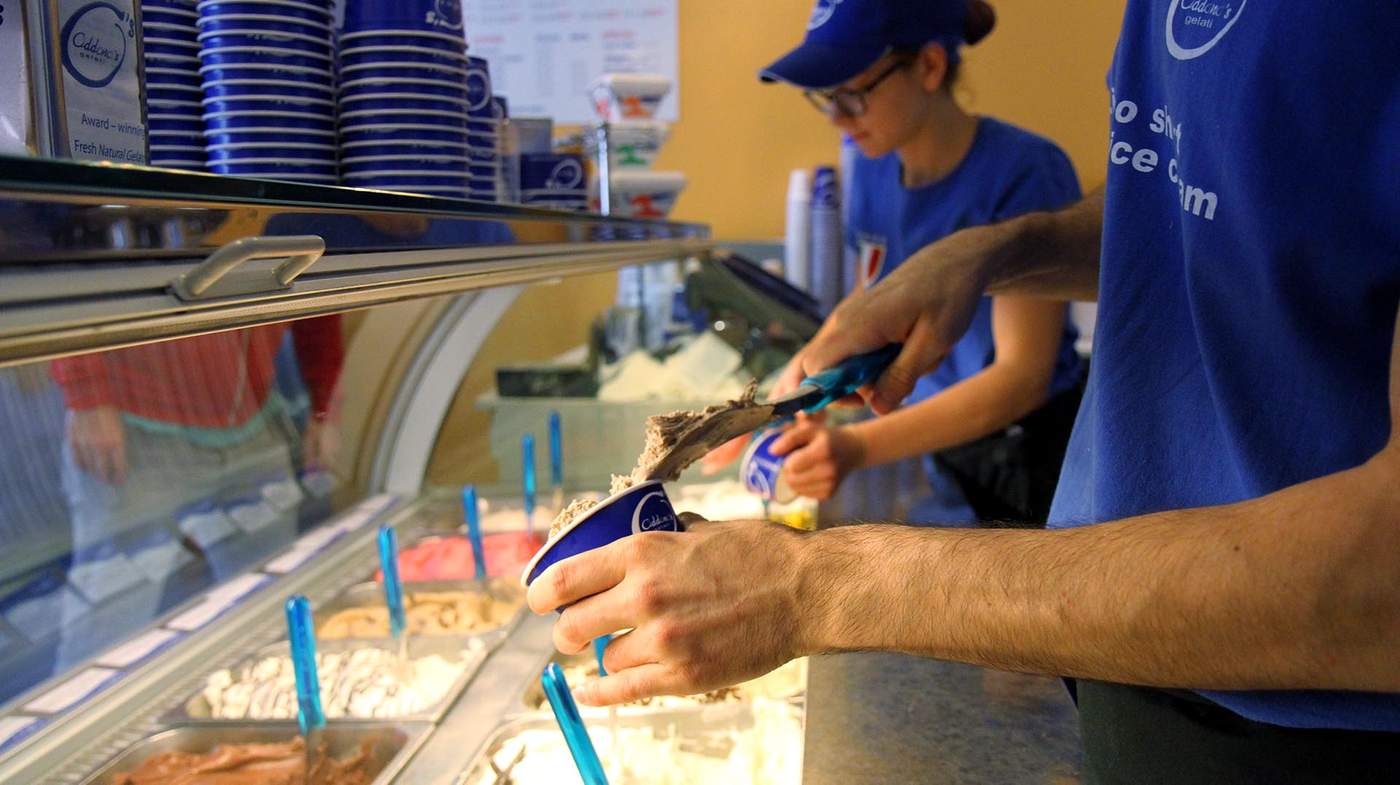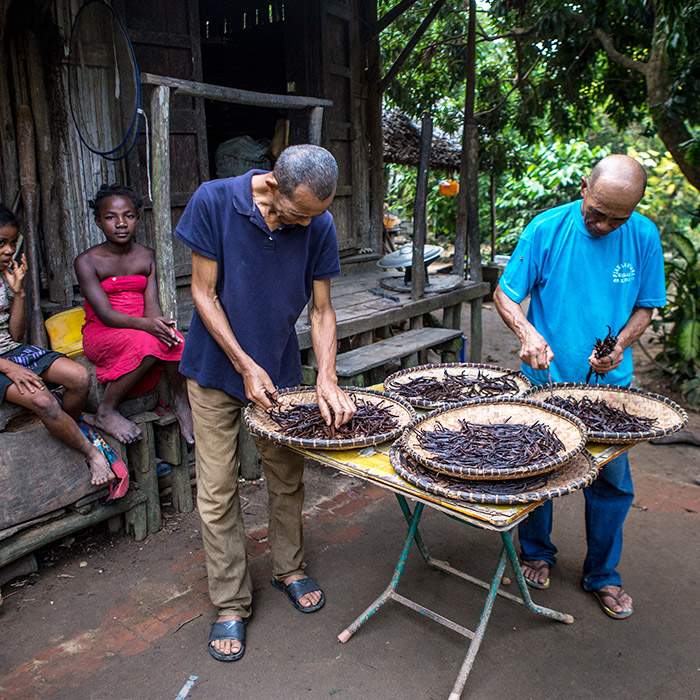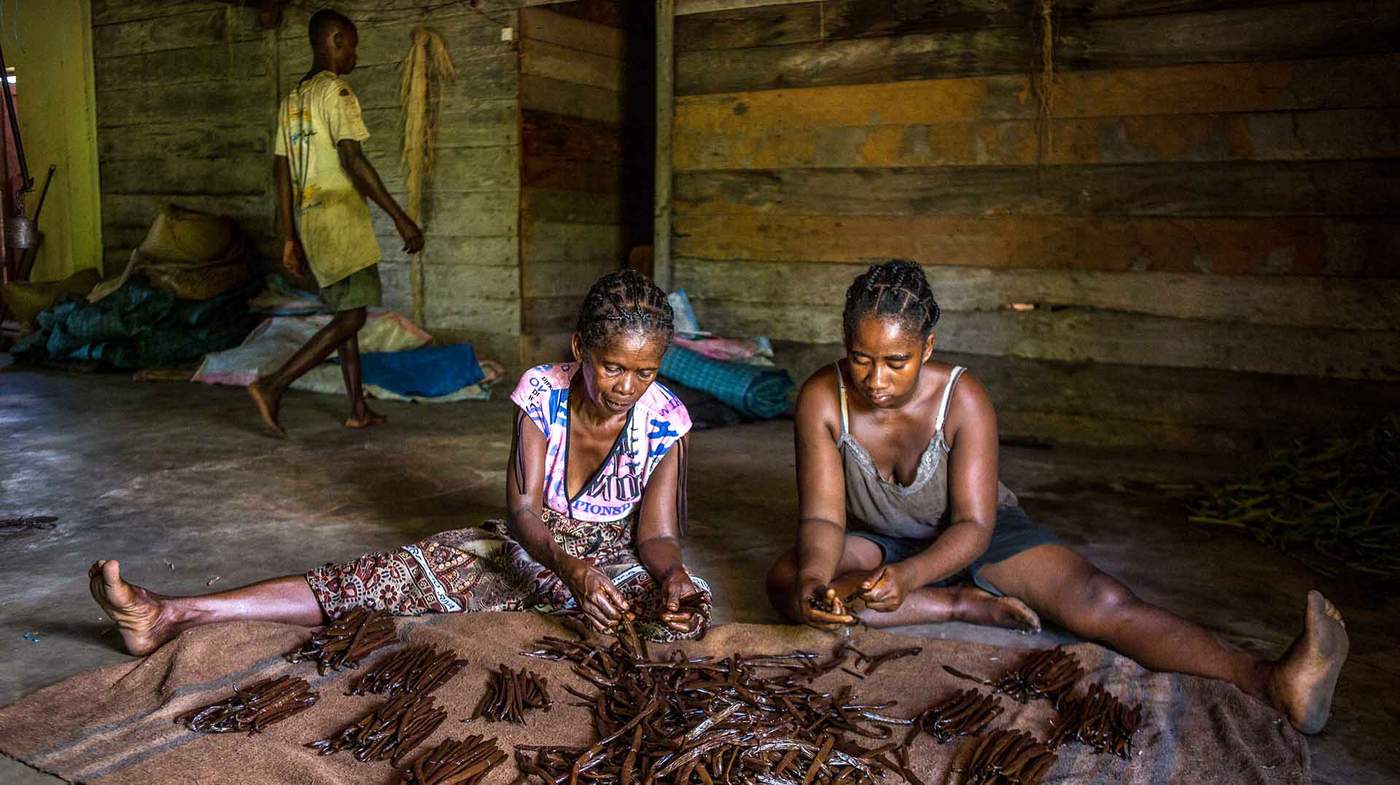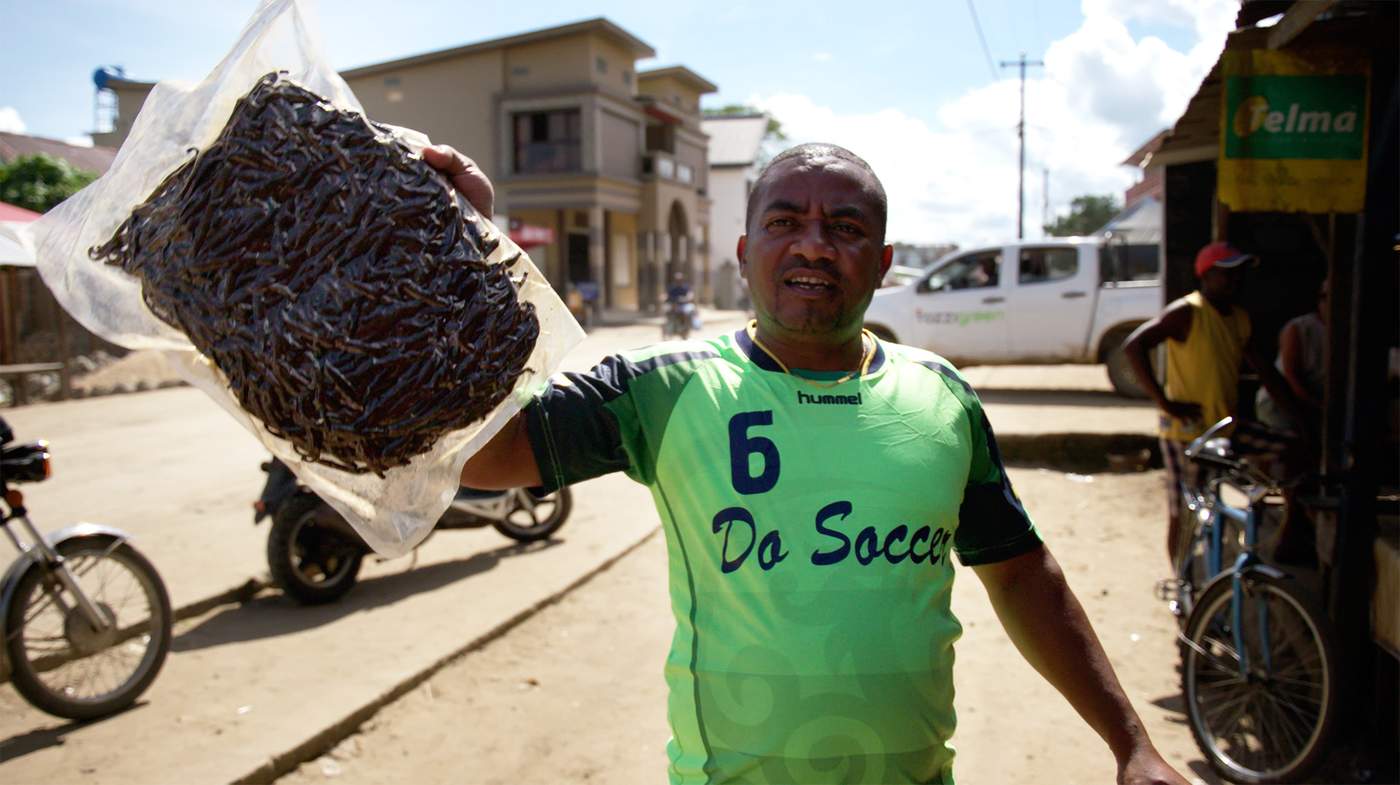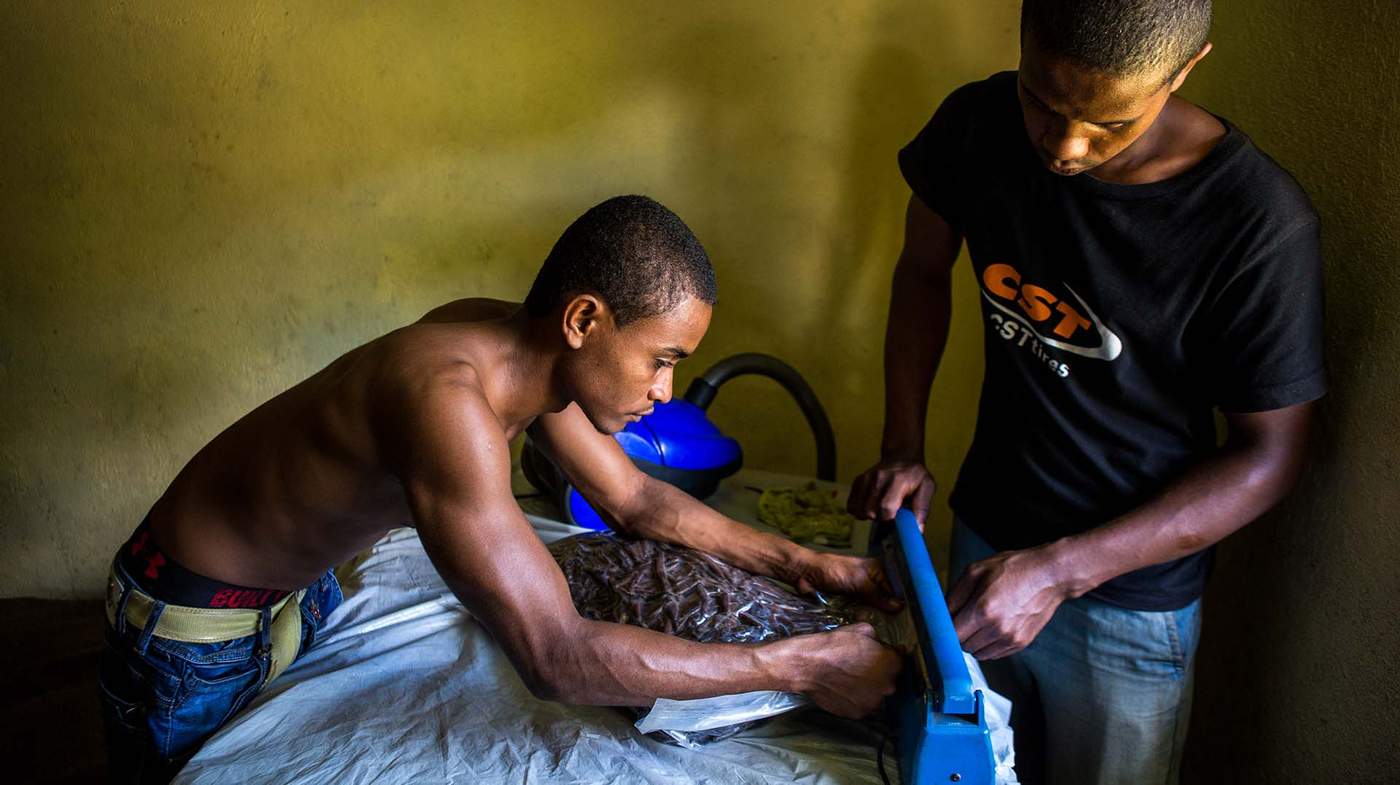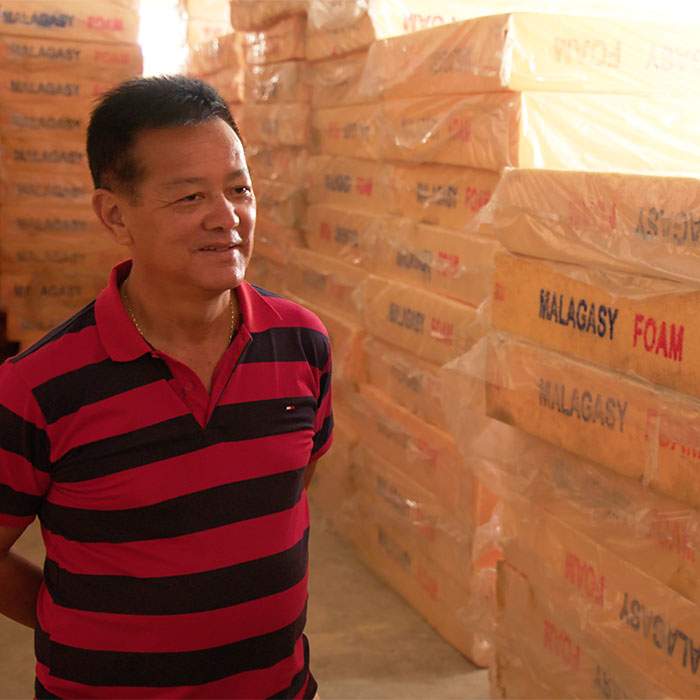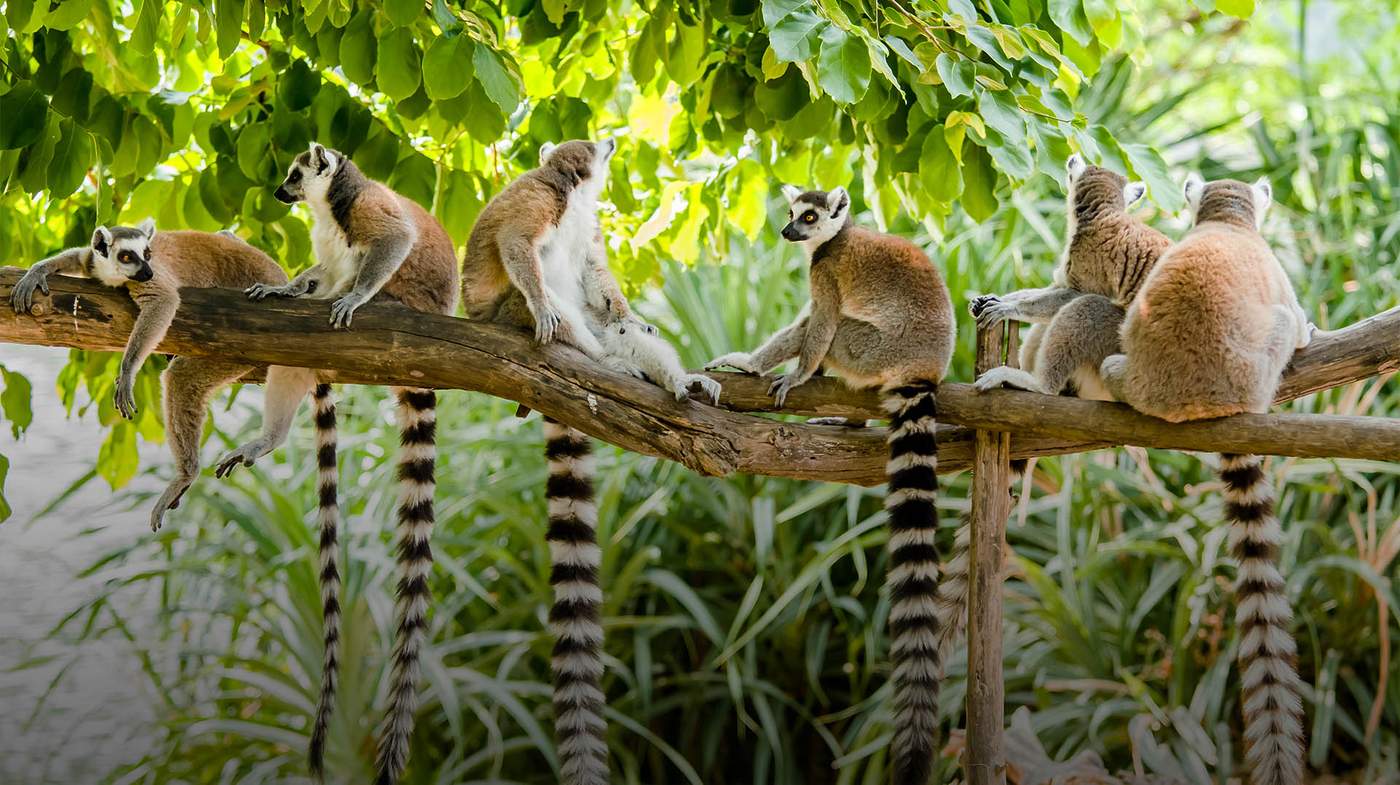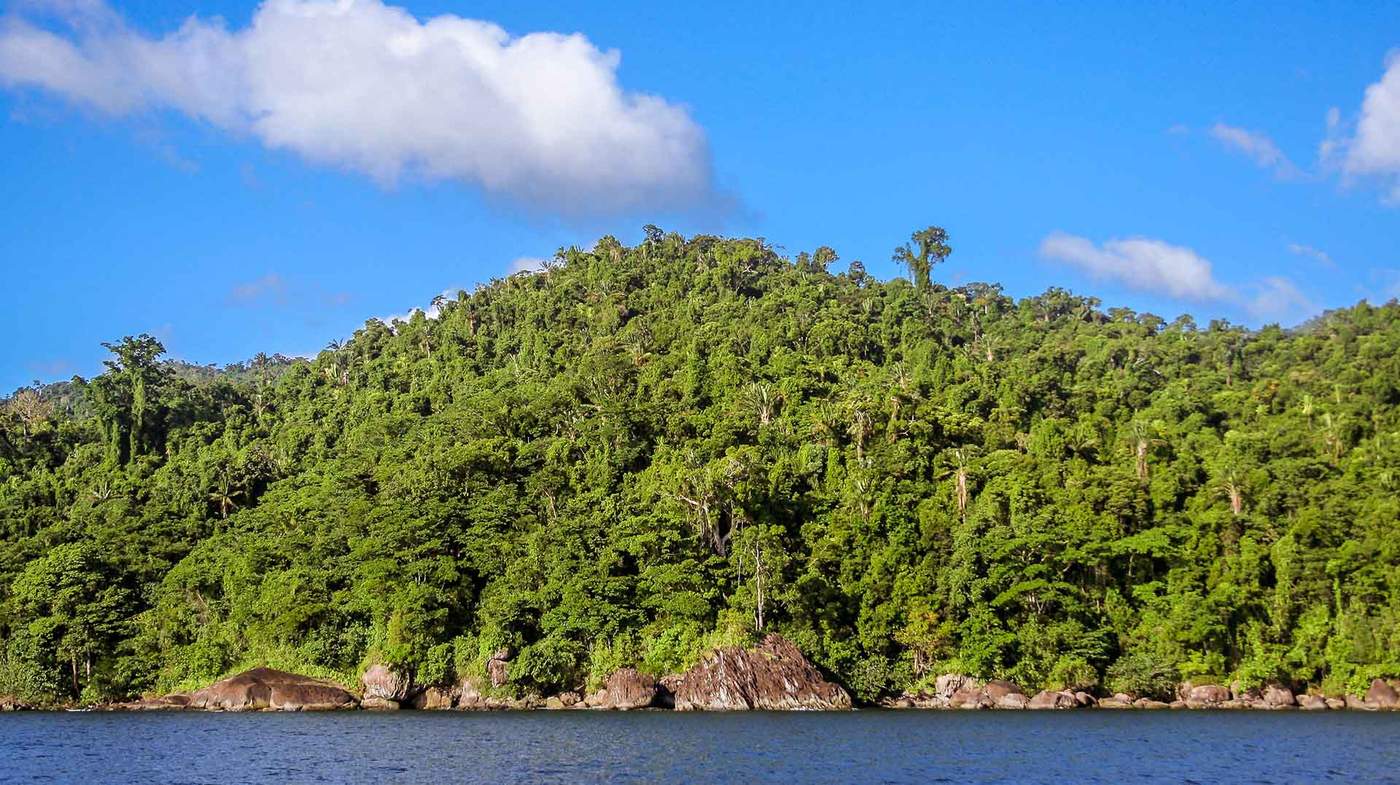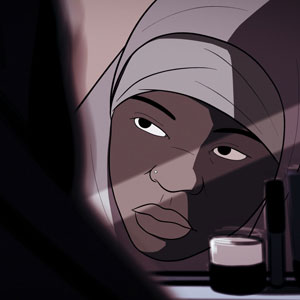A barefoot farmer is making his way through a forest.
Quiet drops of rain tumble steadily through the night, picked out in the light from his torch.
The rusty machete he holds isn’t for cutting down vines or chopping away stubborn branches - it is a defence against thieves.
Lots of other men - farmers like him - are out in the rain, patrolling the forest. For the past three months, they have left their homes every night and made the long journey into the plantations to protect their crop.
But this is not an illegal coca plantation, or anything like it. In fact, these farmers are growing a crop whose name is a byword for something boring.
The men need weapons to guard against robbers who roam the countryside looking for one thing - Madagascan vanilla.
They show that these vanilla vines belong to Leon Charles.
That’s my name. My nickname - people here call me Baba.”
Leon is with his wife, Oristin, in their garden, where they grow coffee and vanilla in the village of Ambanizana, at the edge of the Masoala National Park, in the north-east corner of Madagascar.
It’s a hard place to get to - there are no roads to speak of. From the island’s capital, Antananarivo, it takes two flights, two hours on a speedboat and another 30 minutes in a canoe to reach Ambanizana.

The island of Madagascar is the world's largest producer of vanilla beans
The village is full of music. Upbeat dance melodies blare through the sheer, pink curtain covering the doorway of Leon’s home - a rectangular, wooden structure with a peaked roof.
Here, the forest meets the sea and the high humidity, shade, and moderate temperatures make it perfect for growing vanilla.
Each vine that Leon prunes holds pods - also known as beans - that will eventually retail for more than $150 (£120), once they are dried.
To deter theft, all the farmers in the surrounding area are stamping their names, or sometimes serial numbers, on to individual pods while they’re still on the vine. Even when the pods are dried, the markings can be made out.
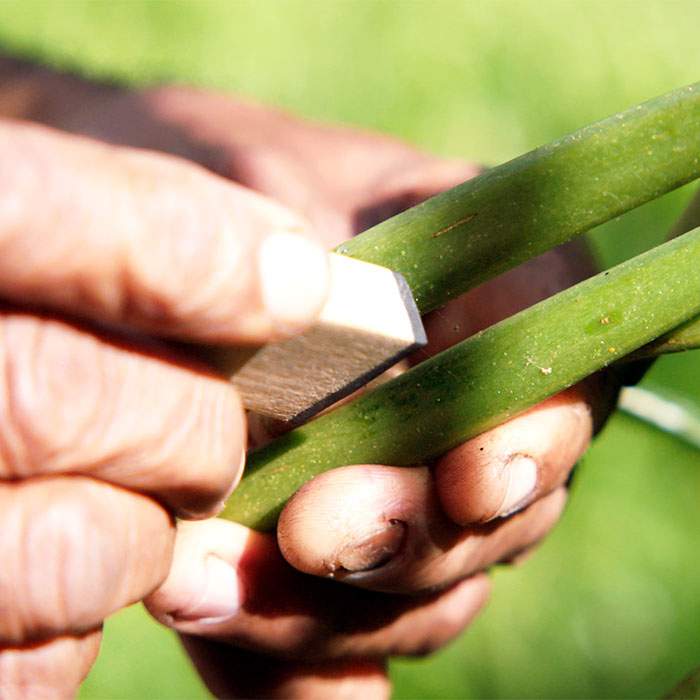
Leon was robbed before last year’s harvest - and it was devastating for his family. “I was working in my [nearby] rice field when they quickly took advantage in order to steal,” he says. “I was so sad, I even cried, because we lost everything. I didn’t have money to send the children to school. Our household has been experiencing hardship for a whole year.”
But it could have been even worse.
The robberies are often violent. There have been dozens of murders in Madagascar linked to vanilla. Several communities have tried and failed to get protection from armed police.
Some have taken the law into their own hands. Villagers say in a nearby village, a machete-wielding crowd descended on five suspected gangsters - hacking and stabbing them to death.
The killings have yet to be solved by the police. Locals say there is no will or capacity in the police forces to investigate the vanilla thefts - or the mob justice that sometimes follows.
The chief of Leon’s village fears the same thing could happen there. A youngish-looking man, Chief Oreis is wearing shorts and sandals with a bright purple shirt when he stops by Leon’s house to say hello. His expression grows stern when he talks about the vanilla thefts.
“We have to do our best to make sure thieves are not able to steal from us here,” he says. “Because if someone’s livelihood is taken away, they can do anything, even kill.”
Thousands of miles away in London, Oddono’s ice cream shop is tucked between a pizza parlour and a cafe on a busy street in South Kensington.
There’s a plethora of awards on one wall. The owners boast of the finest natural ingredients in their authentic Italian gelato: Valrhona chocolate from France, pistachios from Sicily, hazelnuts from Piedmont.
But last year, one variety of ice cream was missing.
“When I told customers that we didn’t have any vanilla ice cream, many of them were shocked,” says Christian Oddono, who manages the shop.
“I had to explain that we didn’t want to give them bad quality products but also we were never going to use chemicals. Then, they understood.”
The price for last year’s Madagascan vanilla crop was sky high, but Christian found the quality of what he was getting so low that he took vanilla ice cream off his menu.
“The pods had too much moisture in them and some even had a mouldy smell - a sign that the curing process wasn’t done properly,” he says.
“This year I found another, better supplier in Madagascar. The prices are still high, so we’ve had to raise our prices as well, but our customers haven’t complained.
We see a general trend of more customers wanting to eat more authentic food and shying away from chemicals and lab-produced substitutes.”
Thousands of miles away in London, Oddono’s ice cream shop is tucked between a pizza parlour and a cafe on a busy street in South Kensington.
There’s a plethora of awards on one wall. The owners boast of the finest natural ingredients in their authentic Italian gelato: Valrhona chocolate from France, pistachios from Sicily, hazelnuts from Piedmont.
But last year, one variety of ice cream was missing.
“When I told customers that we didn’t have any vanilla ice cream, many of them were shocked,” says Christian Oddono, who manages the shop. “I had to explain that we didn’t want to give them bad quality products but also we were never going to use chemicals. Then, they understood.”
The price for last year’s Madagascan vanilla crop was sky high, but Christian found the quality of what he was getting so low that he took vanilla ice cream off his menu.
“The pods had too much moisture in them and some even had a mouldy smell - a sign that the curing process wasn’t done properly,” he says. “This year I found another, better supplier in Madagascar. The prices are still high, so we’ve had to raise our prices as well, but our customers haven’t complained. We see a general trend of more customers wanting to eat more authentic food and shying away from chemicals and lab-produced substitutes.”
We are used to seeing vanilla all around us - in candles, cupcakes and creme brulees. But if you’re eating something vanilla-flavoured or smelling something vanilla-scented - it’s probably artificial.
Scientists have been making synthetic vanillin - the compound that gives vanilla its aroma - since the 19th Century. It has been extracted from coal, tar, rice bran, wood pulp and even cow dung.
Today, the vast majority of comes from petrochemicals.
It can be than the real thing.
The burgeoning interest in “artisanal” food made in a traditional way explains some of the demand for natural vanilla. But much of the rocketing price can be put down to food rules on both sides of the Atlantic.
In Europe and the United States, ice cream labelled “vanilla” must contain natural vanillin extract from vanilla pods. If the flavour comes wholly or partly from artificial sources, the packaging must say “vanilla flavour” or “artificial vanilla”.
Vanilla from vanilla pods will have a taste and potency unique to the area in which it is grown, much like wine. The vanilla from Madagascar has a distinct rummy taste and sweet aroma, which is why ice-cream makers choose it over vanilla from other countries.
And there is more and more pressure on food companies to switch from artificial vanilla to vanilla beans. Big corporations such as Hershey and Nestle have started buying natural vanilla extract for their products in large quantities, which injects more demand into the limited supply chain and raises prices further.
We are used to seeing vanilla all around us - in candles, cupcakes and creme brulees. But if you’re eating something vanilla-flavoured or smelling something vanilla-scented - it’s probably artificial.
Scientists have been making synthetic vanillin - the compound that gives vanilla its aroma - since the 19th Century. It has been extracted from coal, tar, rice bran, wood pulp and even cow dung.
Today, the vast majority of comes from petrochemicals.
It can be than the real thing.
The burgeoning interest in “artisanal” food made in a traditional way explains some of the demand for natural vanilla. But much of the rocketing price can be put down to food rules on both sides of the Atlantic.
In Europe and the United States, ice cream labelled “vanilla” must contain natural vanillin extract from vanilla pods. If the flavour comes wholly or partly from artificial sources, the packaging must say “vanilla flavour” or “artificial vanilla”.
Vanilla from vanilla pods will have a taste and potency unique to the area in which it is grown, much like wine. The vanilla from Madagascar has a distinct rummy taste and sweet aroma, which is why ice-cream makers choose it over vanilla from other countries.
And there is more and more pressure on food companies to switch from artificial vanilla to vanilla beans. Big corporations such as Hershey and Nestle have started buying natural vanilla extract for their products in large quantities, which injects more demand into the limited supply chain and raises prices further.
Over the past decade, vanilla prices have gone through dramatic booms and busts.
Madagascar’s 80,000 growers produce - so what happens on the island affects the global industry.

In March 2017, cyclone Enawo struck the island and destroyed much of that year's crop. Two of the largest vanilla-producing regions were hit directly.
Small growers have since struggled to match demand as it takes three to four years for a new plant to produce vanilla pods. Prices have rocketed.

Source: Reuters
Five years ago, the price of 1kg (2lb 3oz) of vanilla was $20 (£15). In 2018, it briefly became more expensive than silver, reaching a peak of $600 a kilo, before a modest decline to $515 in June.
The vanilla orchid is native to Mexico but it is only a minor producer, having been overtaken by Madagascar in the 1960s. Indonesia is the other big producer.
French colonists first brought vanilla to Madagascar’s neighbouring island of Réunion in the early 19th Century. It grows as a clinging vine, reaching lengths of up to 300ft (90m).
The vines grow well outside Mexico - but no fruit, in the form of vanilla beans, was produced. Horticulturists eventually discovered what was missing.
The pollen on a vanilla orchid flower is inaccessible to most insects, including typical honey bees. The small Melipona bee, which lives in only Mexico, was the only one able to reach the vanilla pollen and fertilise the flowers. Still, relying on the bees for pollination is a hit-and-miss affair as the pale white orchids bloom for just one day each year and the flower is fertile for only eight to 12 hours after it blooms.
On Réunion, an enslaved boy named Edmond Albius invented a painstaking way of pollinating by hand.
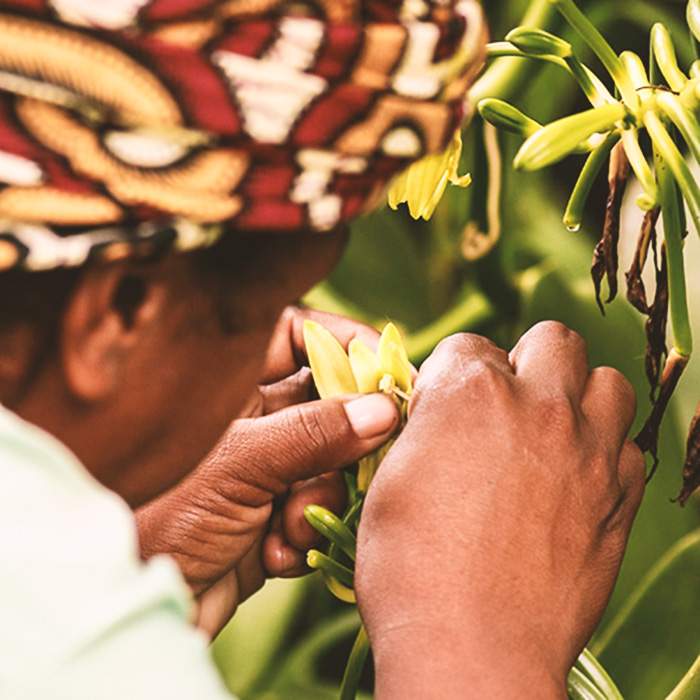
A sharp, thin stick is used to lift the fragile membrane between the male and female parts of the flower, which are then pushed into each other for pollination to occur. This has to be done for every single flower on every vine in order to produce the fruit - vanilla pods filled with thousands of the tiny black seeds we eventually see in high-quality vanilla ice cream.
Madagascan farmers have to check their plants every morning. If a farmer misses the fertilisation window for a flower, or damages the plant, he loses out on precious pods - it takes about 600 blossoms pollinated by hand to produce just 1kg of cured vanilla beans.
After pollination, it takes nine months for the vanilla pods to mature - then, they are harvested.
The still-green beans start to ferment quickly, so buyers must be found fast. Small farmers typically sell green pods to middlemen who gather large amounts to sell on to local exporters.
At this point, the pods do not have the characteristic vanilla smell or taste. The laborious journey - from pollination to curing and drying, and then preparing for export - takes about a year.
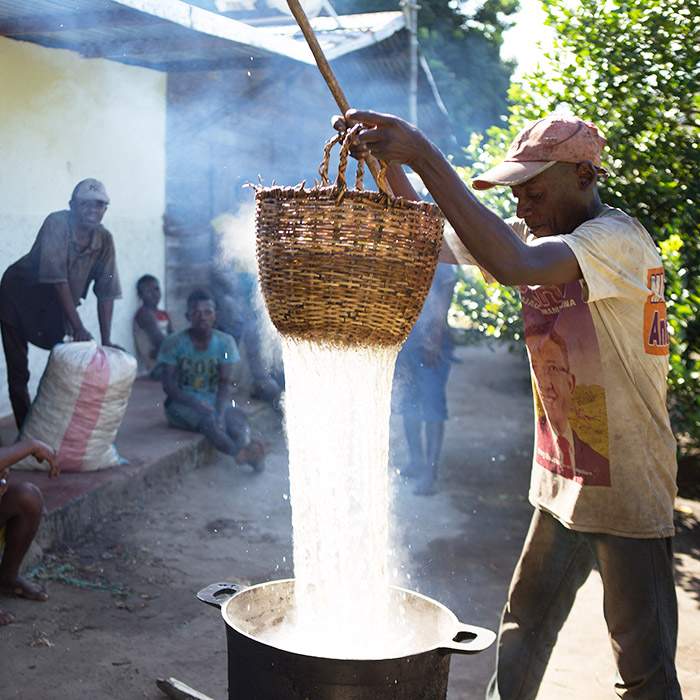
The green beans are immersed in boiling water to stop the fermentation process
The finished product is a brownish-black, heavily wrinkled vanilla bean that is soft, supple and leathery to the touch, with a strong aroma.
On a dusty street in the middle of the market town of Maroantsetra, I am trying to do a deal.
This year’s harvest won’t come in for several more weeks - but the dealers here in the “grey market” may have some to sell.
One “commissionaire” - a middleman - I spoke to nearer to the villages had only 300g (10oz) of the stuff and told me quite honestly: “This is not good quality.” But the group of men sitting under the shade of a row of small shops have managed to produce some, after a long wait.
The goods are delivered on a bright green motorbike. The rider wears gold rings and his necklace catches the light as he pulls me aside to reveal the package.
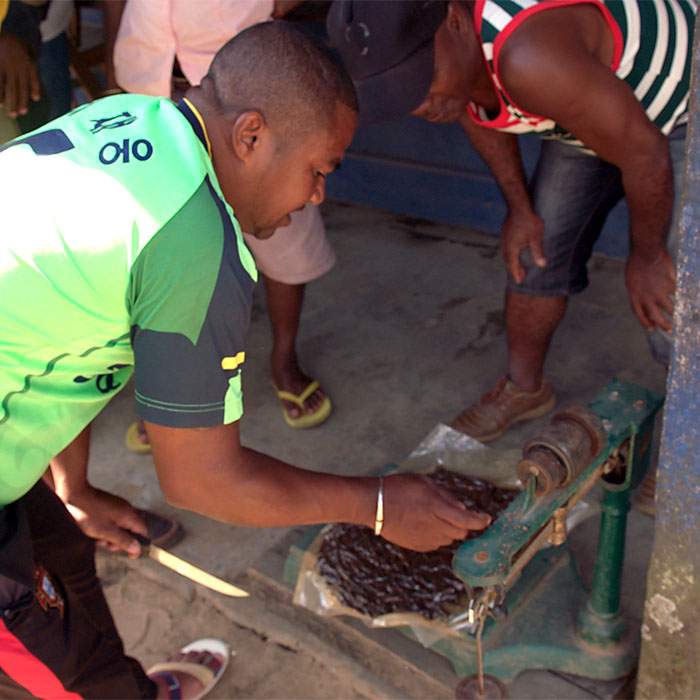
The dealer weighs the vacuum-packed pods
“This is 2kg,” the dealer tells me proudly, “3.3 million ariary.” That’s $1,000. I tell him I can’t afford to buy it. He shrugs and smiles but he is not disappointed - there will be other more serious buyers.
The heavy package is not drugs. Through the clear plastic pouch, coated in a light film of dust, I can see dark, moist vanilla beans.
They are vacuum-sealed - a practice that the government is banning because it plays a part in reducing the quality of the bean that Madagascar is so well known for.
The process can be used by speculators to preserve pods that have been harvested too early. They often store them to sell later at higher prices.
But immature or improperly cured beans have a lower vanillin content and often a mouldy taste.
Many farmers choose to pick their pods early themselves to avoid losing everything to thieves in the last months before the harvest.
The government has tried to stop this by setting fixed harvest dates for each village. To hammer the message home, the authorities recently burned 500kg of prematurely picked pods in public.
But there are smaller middlemen who are under immense pressure to get their beans early - and at a lower price. They get cash advances from big exporters - but they must deliver. Waiting until harvest time, when demand exceeds supply, can be risky.
Arman Ramarokootonirina has been working as a middleman buying up vanilla from farmers in Maroantsetra for more than seven years.
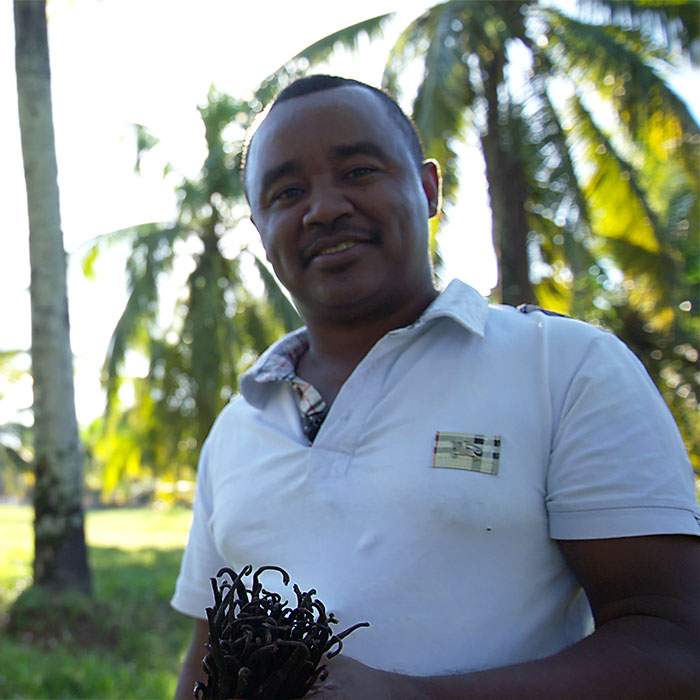
Commissionaire Arman Ramarokootonirina
There are many unscrupulous new entrants into the industry, he says. It is now flush with cash. “It is the greed of the big bosses that is causing the problem. People get big advances yet they haven’t even planted any vanilla. Then they have to steal it from other people’s gardens to fulfill the orders.”
But for the growers who are able to protect their crops, the high vanilla prices mean one good harvest can be life-changing.
A kilogram of cured beans is worth $400-$500 - a hefty sum in a country where the average annual per capita income is $1,500.
In the village of Ambanizana, you can see the vanilla money at work. Parents are able to send their children to bigger, better schools outside the village. Modern brick houses are springing up where traditional wooden houses once stood.
There is a big construction site at the edge of the village. The foreman reveals they are building a disco and restaurant, the first of its kind in Ambanizana.
The owner of the project is a “vanillionaire” - he has made his money both as a vanilla grower and as a commissionaire.
The farmers may be making more money than before - but their small plots of land produce limited amounts of vanilla.
It is the middlemen and the exporters who are raking in the big money. The inaccessibility of the vanilla-growing regions means they are an essential part of the supply chain. Commissionaires travel around the villages, buying up large quantities of green vanilla pods to sell on to big exporting companies who cure and ship them around the world.
In a speedboat cruising down the coast at the edge of Masoala National park, I see bare patches of land breaking up the lush green forest like an ugly rash.
Park ranger Armand Marozafy and environmental activist Clovis Razafimalala say this is the price this park has paid since vanilla prices began to soar.
From the water, they point out more parts of the forest coastline that have been burnt down so that crops - mainly vanilla - can be planted.
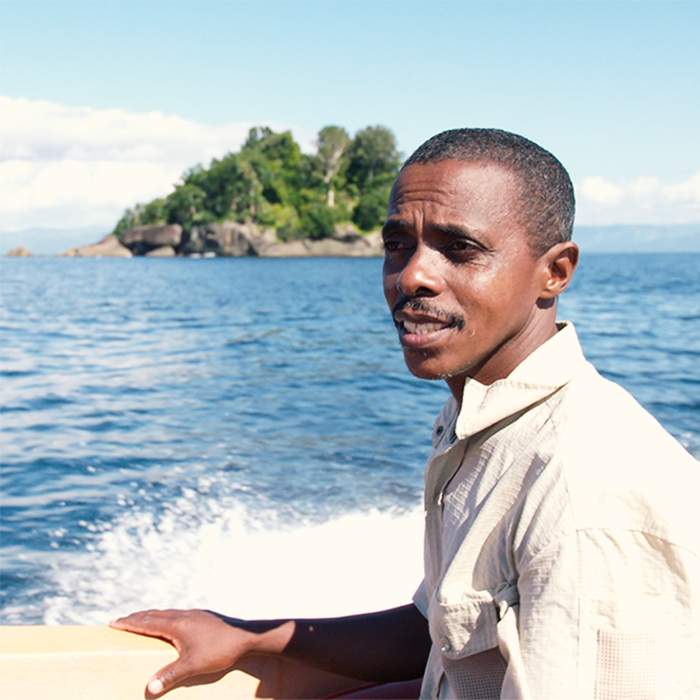
Park ranger Armand Marozafy
Inside the forest, home to endangered lemurs, it becomes even clearer what is at stake. Densely packed trees and unyielding vines suddenly give way to a clearing.
Saplings have sprung up between charred stumps of ancient trees. The trees that were chopped down were more than 100 years old. The clearing is not very big, but as Armand explains, the problem is that there are patches like this all over the place.
Trees and forest that are cut down cannot grow back the same way again - it would take hundreds of years. When this sort of damage occurs, a fragile ecosystem is disrupted. Lemurs will no longer have food here. Plants, insects and animals that relied on a delicate balance start to disappear.
People in Madagascar are worried about its vanilla losing its reputation - but in the national park a fragile ecosystem is being badly damaged to cater for global demand.
It is short-sightedness.
As trees start to disappear, the unique conditions that make this a perfect place to grow vanilla will start to disappear as well. The forests provide the right amount of rainfall, humidity and soil to grow Madagascar’s coveted brand of vanilla.
Cutting down forest to grow more vanilla will eventually make it harder to grow quality vanilla on the island. The industry will have to find ways to ensure consistent quality in order to prevent buyers from looking elsewhere.
Francois Ravelonjara, a vanilla farmer in Maroansetra, wears an air of resignation as he stamps a serial number on to vanilla pods in his small farm.

Farmer Francois Ravelonjara
The number corresponds to one in his carte de planteur de vanille, a registration document distributed to vanilla growers by the government to prove ownership and curb theft.
The markings have not prevented thieves from raiding his plot twice already.
It would be better if the prices went down again,” he says. “We didn’t make much - but at least we did not live in fear.”
Many long-term growers and traders echo that sentiment. Much like the blooming of the vanilla orchid flower, they know the current boom will not last very long. But the effects of it will.
